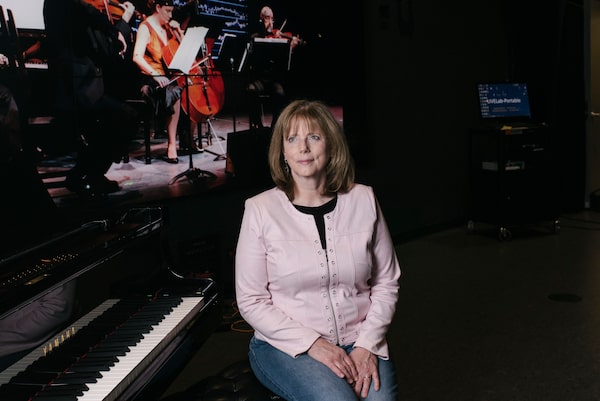
Dr. Laurel Trainor, the founding director of the McMaster Institute for Music and the Mind.Hannah Yoon/The Globe and Mail
This is part of Stepping Up, a series introducing Canadians to their country’s new sources of inspiration and leadership.
What lessons does a string quartet hold for a mother who is suffering from postpartum depression? How could the movements of a dancer help improve those of a Parkinson’s patient?
The LIVELab at McMaster University has been researching questions such as these for four years and coming up with some intriguing answers. Located at McMaster’s Institute for Music and the Mind, the lab is a unique institution, both a 106-seat live performance space and a cutting-edge research facility; it opened its doors in September, 2014, and immediately began producing a concert series and some promising studies.
Director Laurel Trainor, a neuroscientist who studies infants’ relationship with music and speech, has been focusing on the unconscious messages we send with body sway. Using the lab’s motion capture technology – the same filming techniques used in movies such as Planet of the Apes – the lab recorded string quartets at work to discover how musicians keep time with each other and correctly follow changes in tempo or volume. While many studies of musicians have focused on their fine motor movements, this one looked at their cognitive planning: How does one player know what another will do before it happens?
The answer, delivered by assessing motion-capture video, was that the musicians are reading each other’s swaying bodies.
“Musicians have a lot of trouble not swaying, even though they don’t need it to actually play their instrument,” Trainor said. “We found … body sway is communicative.”
Trainor then applied these lessons about movement to her own clinical work to enhance how parents interact with babies.
“We think potentially it’s a pretty powerful tool,” she said, adding that the research could be used to intervene in situations such as postpartum depression where a mother is failing to communicate with an infant. Similarly, by offering a way of reading unconscious communication, the insights into body movement might be used for caregivers or music therapists working to help people with dementia.
Meanwhile, Trainor’s colleague Matthew Woolhouse, a music professor at McMaster’s school of the arts, is using motion capture from dance performances to develop a computer game that will provide therapy for Parkinson’s patients. The dancers’ movements are placed on a human avatar and players are then asked to copy them. A form of individualized therapy, the game will respond to the player, slowing down or speeding up as necessary, not only exercising patients and but also gradually improving the quality of their movements in daily life.
Researchers are also busy testing hearing aids in the LIVELab, an acoustically dead space where a virtual soundscape can be built up to simulate a noisy restaurant or streets. (Many hearing aids wind up lying in a drawer because they are fitted in quiet offices and don’t provide much help in real-life situations.) Another project involves working with the Hamilton Philharmonic Orchestra to enhance the quality of the signal that is sent to hearing-aid wearers by concert-hall sound enhancement technology. Next spring, the orchestra will be holding a special concert for hearing-aid wearers to test improvements developed in the lab.
And there are lots of concerts in the lab itself: The flute/harp duo of Suzanne Shulman and Erica Goodman will be playing there on Dec. 6. LIVELab can use its technology not only to test performers but also to measure audience reaction during shows. For example, a recent album release party for the band Big Wreck found that fans moved more in response to live music than they did to recorded, and also moved more than non-fans.
Yet another area of study aims to help artists suffering performance anxiety, a taboo topic among musicians that Trainor says could be improved by reducing the stigma and increasing the intervention.
A flutist, she is a gifted amateur musician herself, but her chief anxiety is raising the lab’s $500,000 budget from grants and donations. “Funding is a huge challenge,” she said. “That is what keeps me up at night.”
Read more in the Stepping Up series:
How one artistic director is casting for more diversity on stage
The animation executive who makes parents' lives easier
A theatre company without a venue? Yeah, Why Not
Vancouver teacher is schooling educators on the value of inclusive classrooms
Dalhousie Indigenous student showing Canada the way to reconciliation
Toronto human rights lawyer sounds the alarm on Canada’s plans to use AI in immigration
 Kate Taylor
Kate Taylor